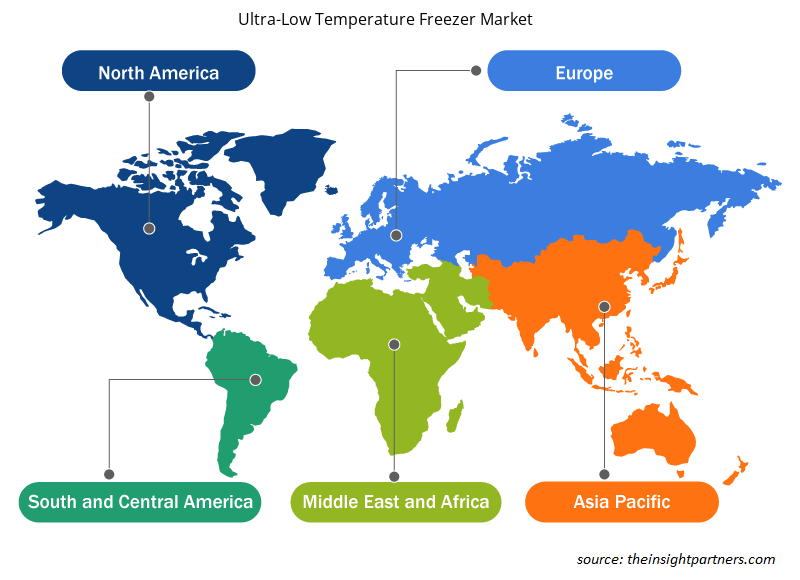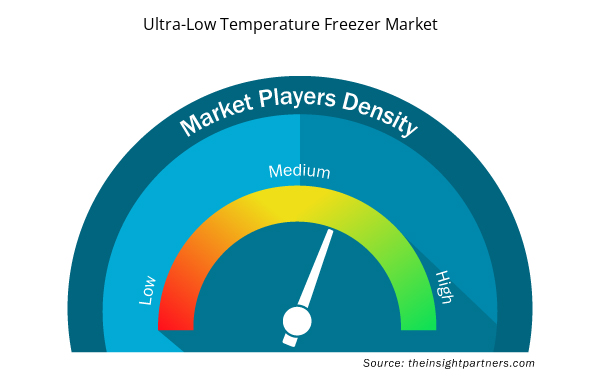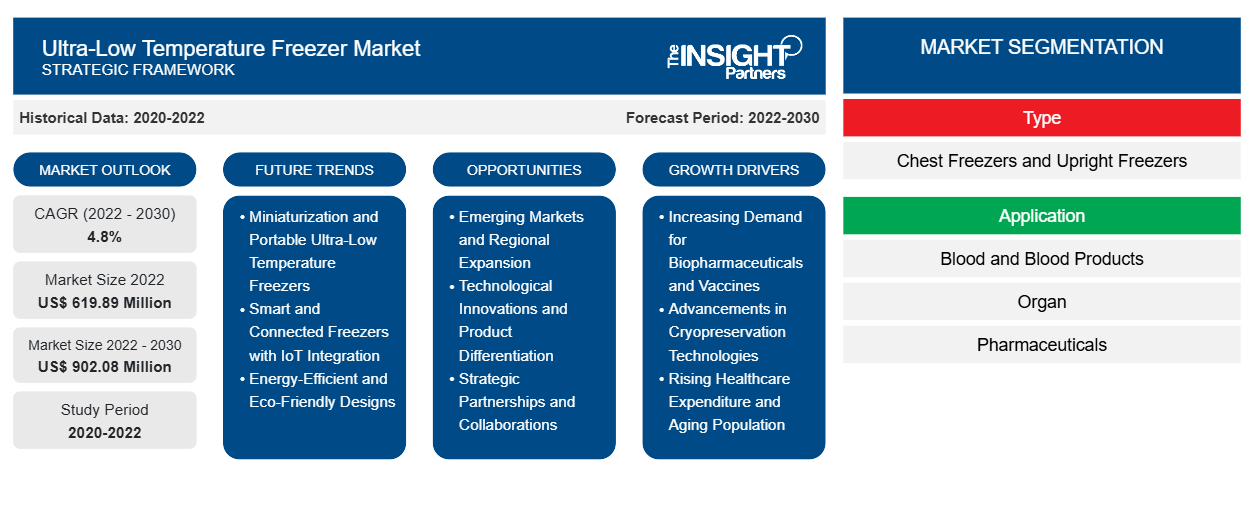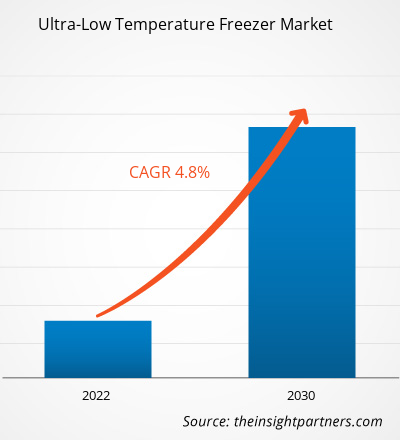[Forschungsbericht] Der Markt für Tiefkühlgeräte soll von 619,89 Millionen US-Dollar im Jahr 2022 auf 902,08 Millionen US-Dollar im Jahr 2030 wachsen; von 2022 bis 2030 wird eine durchschnittliche jährliche Wachstumsrate (CAGR) von 4,8 % erwartet.
Markteinblicke und Analystenansichten:
Der Markt für Ultratiefkühlschränke wächst mit zunehmenden F&E-Aktivitäten zur Einführung neuer Arzneimittelverbindungen, steigender Nachfrage nach Blut und Blutbestandteilen sowie wachsender staatlicher Unterstützung für Forschungsaktivitäten und klinische Studien. Darüber hinaus treibt die Verfügbarkeit fortschrittlicher Produkte durch Marktteilnehmer das Marktwachstum voran. Thermo Scientific Revco RLE –86 °C-Gefrierschränke sind in fünf Kapazitäten erhältlich und bieten Platz für 300 bis 700 2-Zoll-Boxen. Diese Gefrierschränke bieten hervorragende thermische Leistung, Sicherheit und Schutz.
Wachstumstreiber und Herausforderungen:
Proben für biologische Forschung müssen bei Temperaturen unter –80 °C, also bei ultraniedrigen Temperaturen (ULT), gelagert werden. Die ULT-Funktion bietet eine Alternative zur herkömmlichen kompressorbasierten Kühltechnologie, die mit zunehmendem Verständnis immer besser wird. Zu den innovativen Produkten von Haier Biomedical gehören ULT-Gefriergeräte mit intelligenter Frequenzumwandlungstechnologie, die einen beispiellosen Energieverbrauch von nur 8,2 kWh/Tag bei einer Gerätekapazität von 829 l/29,2 ft3 aufweisen. Im Oktober 2022 brachte Thermo Fisher Scientific ein neues Gefriergerät für sein umweltfreundliches Ultratieftemperatur-Portfolio (ULT) auf den Markt, die Thermo Scientific TDE-Serie -80 °C-Gefriertruhe. Das Gefriergerät wird von H-Drive-Kohlenwasserstoffsystemen angetrieben und verbessert die für wichtige Forschungsarbeiten erforderlichen Leistungen, ohne die Nachhaltigkeitsziele zu beeinträchtigen. Im Juni 2023 wurde der ultrakalte ULT-Gefrierschrank Stirling der ISO-Klasse 6 von BioLife Solutions gemäß der einschlägigen Good Manufacturing Practice (GMP) für Reinraumanwendungen zugelassen, ohne die Biolagerungsleistung oder die Sauberkeit der Umgebung zu beeinträchtigen.
ULT-Gefriergeräte zur Probenlagerung sind ein wichtiger Bestandteil vieler Biobanken , Kliniken und Labore weltweit. Diese Geräte können eine große Vielfalt biologischer Proben verarbeiten, darunter DNA, RNA, Proteine und Zellextrakte. Zur Aufrechterhaltung niedriger Temperaturen ist eine konstante Stromversorgung erforderlich. Das International Institute for Sustainable Laboratories gab an, dass ein durchschnittliches ULT-Gefriergerät genauso viel Energie verbraucht (20 kWh pro Tag) wie ein Einfamilienhaus. Wenn man bedenkt, dass Labore und Forschungseinrichtungen normalerweise Dutzende dieser Geräte gleichzeitig betreiben, können die Betriebs- und Energiekosten die Präferenzen der Benutzer dominieren. Die durchschnittlichen Kosten für den Betrieb eines aufrecht stehenden, mechanischen ULT-Gefriergeräts können zwischen 750 US-Dollar (570 GBP) und 1.000 US-Dollar (750 GBP) pro Jahr variieren, abhängig von verschiedenen Faktoren wie Größe und Temperaturbereich. Regelmäßige Wartung und Instandhaltung in Form von Abtauen können diese Kosten erheblich senken. Darüber hinaus berücksichtigen die oben genannten Zahlen zu den ULT-Gefriergeräten nicht die zusätzlichen Kosten für HLK-Systeme und Warmluftabfuhr. Daher werden die mit ULT-Gefriergeräten verbundenen hohen Kosten für preisbewusste Labore und Lagereinrichtungen zu einem ernsten Problem.
Passen Sie diesen Bericht Ihren Anforderungen an
Sie erhalten kostenlose Anpassungen an jedem Bericht, einschließlich Teilen dieses Berichts oder einer Analyse auf Länderebene, eines Excel-Datenpakets sowie tolle Angebote und Rabatte für Start-ups und Universitäten.
- Holen Sie sich die wichtigsten Markttrends aus diesem Bericht.Dieses KOSTENLOSE Beispiel umfasst eine Datenanalyse von Markttrends bis hin zu Schätzungen und Prognosen.
Berichtssegmentierung und -umfang:
Der Markt für Tiefkühltruhen ist nach Typ, Anwendung, Technologie und Geografie segmentiert. Der Markt für Tiefkühltruhen ist nach Typ, Anwendung, Technologie und Geografie segmentiert. Der Markt für Tiefkühltruhen ist nach Anwendung in Blut und Blutprodukte, Organe, Pharmazeutika, forensische und genomische Forschung und andere segmentiert. Der Markt ist nach Technologie in automatische und halbautomatische Geräte unterteilt.
Geografisch ist der Markt für Tiefkühlgeräte in Nordamerika (USA, Kanada und Mexiko), Europa (Großbritannien, Deutschland, Frankreich, Italien, Spanien, Russland und übriges Europa), Asien-Pazifik (China, Japan, Indien, Südkorea, Australien, Südostasien und übriger Asien-Pazifik-Raum), Naher Osten und Afrika (VAE, Saudi-Arabien, Südafrika und übriger Naher Osten und Afrika) sowie Süd- und Mittelamerika (Brasilien, Argentinien und übriges Süd- und Mittelamerika) unterteilt.
Segmentanalyse:
Der Markt für Tiefkühltruhen ist nach Typ in Gefriertruhen und Gefrierschränke unterteilt. Im Jahr 2022 hatte das Segment der Gefrierschränke einen größeren Marktanteil, und es wird erwartet, dass dasselbe Segment zwischen 2022 und 2030 eine höhere CAGR verzeichnet. Das prognostizierte Marktwachstum für das Segment der Gefrierschränke wird auf Vorteile wie kompaktes Design, einfache Organisation und Verfügbarkeit verschiedener Sicherheitsfunktionen zurückgeführt. Darüber hinaus würde eine zunehmende Akzeptanz aufgrund technologischer Fortschritte, die zu einer besseren Überwachung des Betriebs und einer einfacheren Handhabung führen, das Marktwachstum für Tiefkühltruhen im Segment der Gefrierschränke im Prognosezeitraum steigern.
Regionale Analyse:
Geografisch ist der Markt für Tiefkühltruhen in Nordamerika, Europa, Asien-Pazifik, den Nahen Osten und Afrika sowie Süd- und Mittelamerika unterteilt. Nordamerika trägt am meisten zum weltweiten Wachstum des Marktes für Tiefkühltruhen bei. Der asiatisch-pazifische Raum wird voraussichtlich zwischen 2022 und 2030 die höchste durchschnittliche jährliche Wachstumsrate auf dem Markt für Tiefkühltruhen verzeichnen. Das Wachstum des Marktes für Tiefkühltruhen in den USA wird hauptsächlich durch die zunehmende Verbreitung von Lungenkrebs, Produkteinführungen und Regierungsinitiativen vorangetrieben. Die steigende Nachfrage nach Biobanken birgt transformatives Potenzial für das Gesundheits- und Wirtschaftssystem der USA. Der unmittelbare Fokus der raschen Entwicklung von Biobanken im Land wird jedoch durch die Notwendigkeit des Verständnisses von Krankheiten sowie der Entdeckung und Entwicklung von Medikamenten verstärkt. Darüber hinaus liefert die Biobankforschung neue Erkenntnisse über die genetische Komponente menschlicher Krankheiten, wobei der Schwerpunkt auf der Entwicklung eines automatisierten und personalisierteren Ansatzes für die Gesundheitsversorgung liegt. Darüber hinaus konzentrieren sich mehrere Marktteilnehmer in den USA darauf, ein diversifiziertes, hochmodernes Portfolio an Biobanking-Produkten und -Dienstleistungen anzubieten, die lebensrettende Entdeckungen beschleunigen sollen. Die zunehmende Zahl der Geschäftsaktivitäten der Marktteilnehmer trägt dynamisch zum Marktwachstum bei. Im November 2020 hatten Krankenhäuser in den US-Bundesstaaten und Städten Schwierigkeiten, Ultratiefkühlschränke zu kaufen, in denen der COVID-19-Impfstoff PFE.N von Pfizer Inc. sicher gelagert werden kann, und ignorierten dabei den Rat der US-amerikanischen Centers for Disease Control and Prevention (CDC), damit zu warten.
Regionale Einblicke in den Markt für Ultratiefkühlgeräte
Die regionalen Trends und Faktoren, die den Markt für Tiefkühlgeräte im Prognosezeitraum beeinflussen, wurden von den Analysten von Insight Partners ausführlich erläutert. In diesem Abschnitt werden auch die Marktsegmente und die Geografie für Tiefkühlgeräte in Nordamerika, Europa, im asiatisch-pazifischen Raum, im Nahen Osten und Afrika sowie in Süd- und Mittelamerika erörtert.

- Erhalten Sie regionale Daten zum Markt für Ultratiefkühlgeräte
Umfang des Marktberichts über Ultratiefkühlgeräte
| Berichtsattribut | Details |
|---|---|
| Marktgröße im Jahr 2022 | 619,89 Millionen US-Dollar |
| Marktgröße bis 2030 | 902,08 Millionen US-Dollar |
| Globale CAGR (2022 - 2030) | 4,8 % |
| Historische Daten | 2020-2022 |
| Prognosezeitraum | 2022–2030 |
| Abgedeckte Segmente | Nach Typ
|
| Abgedeckte Regionen und Länder | Nordamerika
|
| Marktführer und wichtige Unternehmensprofile |
|
Marktteilnehmerdichte: Der Einfluss auf die Geschäftsdynamik
Der Markt für Ultratiefkühlschränke wächst rasant, angetrieben durch die steigende Nachfrage der Endverbraucher aufgrund von Faktoren wie sich entwickelnden Verbraucherpräferenzen, technologischen Fortschritten und einem größeren Bewusstsein für die Vorteile des Produkts. Mit steigender Nachfrage erweitern Unternehmen ihr Angebot, entwickeln Innovationen, um die Bedürfnisse der Verbraucher zu erfüllen, und nutzen neue Trends, was das Marktwachstum weiter ankurbelt.
Die Marktteilnehmerdichte bezieht sich auf die Verteilung der Firmen oder Unternehmen, die in einem bestimmten Markt oder einer bestimmten Branche tätig sind. Sie gibt an, wie viele Wettbewerber (Marktteilnehmer) in einem bestimmten Marktraum im Verhältnis zu seiner Größe oder seinem gesamten Marktwert präsent sind.
Die wichtigsten auf dem Markt für Ultratiefkühlgeräte tätigen Unternehmen sind:
- Thermo Fisher Scientific Inc
- Godrej-Gruppe
- Haier Group Corporation
- Blue Star Limited
- Helmer Scientific Inc
Haftungsausschluss : Die oben aufgeführten Unternehmen sind nicht in einer bestimmten Reihenfolge aufgeführt.

- Überblick über die wichtigsten Akteure auf dem Markt für Ultratiefkühlgeräte
Branchenentwicklungen und zukünftige Chancen:
Nachfolgend sind verschiedene Initiativen wichtiger Akteure auf dem Markt für Ultratiefkühlgeräte aufgeführt:
- Im Mai 2023 gab die PHC Corporation of North America (PHCNA) bekannt, dass der Ultratiefkühlschrank VIP ECO SMART der Marke PHCbi von der International Society for Biological and Environmental Repositories (ISBER) mit dem renommierten Outstanding New Product Award für 2023 ausgezeichnet wurde. Das Produkt ist für den Einsatz in einer Reihe von Einrichtungen wie Universitäten, medizinischen Einrichtungen und Pharmaunternehmen konzipiert .
- Im Februar 2023 brachte die PHC Corporation of North America (PHCNA) die Ultratiefkühltruhenserie VIP ECO SMART der Marke PHCbi auf den Markt. Diese neue Serie basiert auf innovativen und zuverlässigen Ultratiefkühltruhen, die eine verbesserte Energiesparleistung bei gleichzeitig verbesserter Sicherheit und Benutzerfreundlichkeit bieten.
Wettbewerbslandschaft und Schlüsselunternehmen:
Thermo Fisher Scientific Inc, Godrej Group, Haier Group Corporation, Blue Star Limited, Helmer Scientific Inc, PHC Holdings, BioLife Solutions Inc, Eppendorf SE, Meling Biomedical und Arctiko gehören zu den führenden Akteuren auf dem Markt für Ultratiefkühlgeräte. Diese Unternehmen konzentrieren sich auf die Einführung neuer Produkte und die geografische Expansion, um die weltweit wachsende Verbrauchernachfrage zu befriedigen und ihr Produktangebot in Spezialportfolios zu erweitern. Ihre globale Präsenz ermöglicht es ihnen, einen großen Kundenstamm zu bedienen und so die Marktexpansion zu erleichtern.
- Historische Analyse (2 Jahre), Basisjahr, Prognose (7 Jahre) mit CAGR
- PEST- und SWOT-Analyse
- Marktgröße Wert/Volumen – Global, Regional, Land
- Branche und Wettbewerbsumfeld
- Excel-Datensatz


- Dry Eye Products Market
- 3D Mapping and Modelling Market
- Surety Market
- Electronic Data Interchange Market
- Aircraft Wire and Cable Market
- Airline Ancillary Services Market
- Photo Editing Software Market
- Virtual Pipeline Systems Market
- Medical and Research Grade Collagen Market
- Point of Care Diagnostics Market

Report Coverage
Revenue forecast, Company Analysis, Industry landscape, Growth factors, and Trends

Segment Covered
This text is related
to segments covered.

Regional Scope
North America, Europe, Asia Pacific, Middle East & Africa, South & Central America

Country Scope
This text is related
to country scope.
Häufig gestellte Fragen
The increasing demand for blood and blood components, and technological advancements in ultra-low temperature freezer bolster the ultra-low temperature freezer market size. However, the high cost associated with ultra-low temperature freezer hinders the ultra-low temperature freezer market growth.
Based on geography, the ultra-low temperature freezer market is segmented into North America (the US, Canada, and Mexico), Europe (the UK, Germany, France, Italy, Spain, and the Rest of Europe), Asia Pacific (China, Japan, India, South Korea, Australia, and the Rest of Asia Pacific), the Middle East & Africa (the UAE, Saudi Arabia, South Africa, and Rest of the Middle East & Africa), and South & Central America (Brazil, Argentina, and the Rest of South & Central America). North America is the largest contributor to the growth of the global ultra-low temperature freezer market. Asia Pacific is expected to register the highest CAGR in the ultra-low temperature freezer market during 2022–2030.
The ultra-low temperature freezer market is divided on the basis of type, application, and technology. The ultra-low temperature freezer market, by type, is bifurcated into chest freezers and upright freezers. In 2022, the upright segment held a larger market share. Further, the upright segment is expected to record a faster CAGR during 2022–2030.
The ultra-low temperature freezer market, by application, is segmented into blood & blood products, organs, pharmaceuticals, forensic & genomic research, and others. In 2022, the blood & blood products segment held a largest market share. Further, the pharmaceuticals segment is expected to record a fastest CAGR during 2022–2030.
The market, by technology, is bifurcated into automatic and semi-automatic. In 2022, the automatic segment held a larger market share. Further, the automatic segment is expected to record a faster CAGR during 2022–2030.
Ultra-Low temperature freezers are designed to store biological materials such as viruses, bacteria, eukaryotic cells, blood, and semen. These freezers are used in blood banks, hospitals, epidemic prevention services, research institutes, and biomedical engineering facilities. These are available in different specifications to suit specific commercial needs. For instance, the plasma once is used for storage of blood and plasma products at -30°C to 40°C, and the ultra-low temperature freezers are used for long term storage of DNA and RNA samples products at a range of 70°C to 80 °C.
The ultra-low temperature freezer market majorly consists of the players such Thermo Fisher Scientific Inc, Godrej Group, Haier Group Corporation, Blue Star Limited, Helmer Scientific Inc, PHC Holdings, BioLife Solutions Inc, Eppendorf SE, Meling Biomedical, and Arctiko among others.
Trends and growth analysis reports related to Life Sciences : READ MORE..
The List of Companies - Ultra-Low Temperature Freezer Market
- Thermo Fisher Scientific Inc
- Godrej Group
- Haier Group Corporation
- Blue Star Limited
- Helmer Scientific Inc
- PHC Holdings
- BioLife Solutions Inc
- Eppendorf SE
- Meling Biomedical
- Arctiko
The Insight Partners performs research in 4 major stages: Data Collection & Secondary Research, Primary Research, Data Analysis and Data Triangulation & Final Review.
- Data Collection and Secondary Research:
As a market research and consulting firm operating from a decade, we have published and advised several client across the globe. First step for any study will start with an assessment of currently available data and insights from existing reports. Further, historical and current market information is collected from Investor Presentations, Annual Reports, SEC Filings, etc., and other information related to company’s performance and market positioning are gathered from Paid Databases (Factiva, Hoovers, and Reuters) and various other publications available in public domain.
Several associations trade associates, technical forums, institutes, societies and organization are accessed to gain technical as well as market related insights through their publications such as research papers, blogs and press releases related to the studies are referred to get cues about the market. Further, white papers, journals, magazines, and other news articles published in last 3 years are scrutinized and analyzed to understand the current market trends.
- Primary Research:
The primarily interview analysis comprise of data obtained from industry participants interview and answers to survey questions gathered by in-house primary team.
For primary research, interviews are conducted with industry experts/CEOs/Marketing Managers/VPs/Subject Matter Experts from both demand and supply side to get a 360-degree view of the market. The primary team conducts several interviews based on the complexity of the markets to understand the various market trends and dynamics which makes research more credible and precise.
A typical research interview fulfils the following functions:
- Provides first-hand information on the market size, market trends, growth trends, competitive landscape, and outlook
- Validates and strengthens in-house secondary research findings
- Develops the analysis team’s expertise and market understanding
Primary research involves email interactions and telephone interviews for each market, category, segment, and sub-segment across geographies. The participants who typically take part in such a process include, but are not limited to:
- Industry participants: VPs, business development managers, market intelligence managers and national sales managers
- Outside experts: Valuation experts, research analysts and key opinion leaders specializing in the electronics and semiconductor industry.
Below is the breakup of our primary respondents by company, designation, and region:

Once we receive the confirmation from primary research sources or primary respondents, we finalize the base year market estimation and forecast the data as per the macroeconomic and microeconomic factors assessed during data collection.
- Data Analysis:
Once data is validated through both secondary as well as primary respondents, we finalize the market estimations by hypothesis formulation and factor analysis at regional and country level.
- Macro-Economic Factor Analysis:
We analyse macroeconomic indicators such the gross domestic product (GDP), increase in the demand for goods and services across industries, technological advancement, regional economic growth, governmental policies, the influence of COVID-19, PEST analysis, and other aspects. This analysis aids in setting benchmarks for various nations/regions and approximating market splits. Additionally, the general trend of the aforementioned components aid in determining the market's development possibilities.
- Country Level Data:
Various factors that are especially aligned to the country are taken into account to determine the market size for a certain area and country, including the presence of vendors, such as headquarters and offices, the country's GDP, demand patterns, and industry growth. To comprehend the market dynamics for the nation, a number of growth variables, inhibitors, application areas, and current market trends are researched. The aforementioned elements aid in determining the country's overall market's growth potential.
- Company Profile:
The “Table of Contents” is formulated by listing and analyzing more than 25 - 30 companies operating in the market ecosystem across geographies. However, we profile only 10 companies as a standard practice in our syndicate reports. These 10 companies comprise leading, emerging, and regional players. Nonetheless, our analysis is not restricted to the 10 listed companies, we also analyze other companies present in the market to develop a holistic view and understand the prevailing trends. The “Company Profiles” section in the report covers key facts, business description, products & services, financial information, SWOT analysis, and key developments. The financial information presented is extracted from the annual reports and official documents of the publicly listed companies. Upon collecting the information for the sections of respective companies, we verify them via various primary sources and then compile the data in respective company profiles. The company level information helps us in deriving the base number as well as in forecasting the market size.
- Developing Base Number:
Aggregation of sales statistics (2020-2022) and macro-economic factor, and other secondary and primary research insights are utilized to arrive at base number and related market shares for 2022. The data gaps are identified in this step and relevant market data is analyzed, collected from paid primary interviews or databases. On finalizing the base year market size, forecasts are developed on the basis of macro-economic, industry and market growth factors and company level analysis.
- Data Triangulation and Final Review:
The market findings and base year market size calculations are validated from supply as well as demand side. Demand side validations are based on macro-economic factor analysis and benchmarks for respective regions and countries. In case of supply side validations, revenues of major companies are estimated (in case not available) based on industry benchmark, approximate number of employees, product portfolio, and primary interviews revenues are gathered. Further revenue from target product/service segment is assessed to avoid overshooting of market statistics. In case of heavy deviations between supply and demand side values, all thes steps are repeated to achieve synchronization.
We follow an iterative model, wherein we share our research findings with Subject Matter Experts (SME’s) and Key Opinion Leaders (KOLs) until consensus view of the market is not formulated – this model negates any drastic deviation in the opinions of experts. Only validated and universally acceptable research findings are quoted in our reports.
We have important check points that we use to validate our research findings – which we call – data triangulation, where we validate the information, we generate from secondary sources with primary interviews and then we re-validate with our internal data bases and Subject matter experts. This comprehensive model enables us to deliver high quality, reliable data in shortest possible time.


 Holen Sie sich ein kostenloses Muster für diesen Bericht
Holen Sie sich ein kostenloses Muster für diesen Bericht